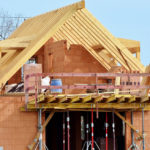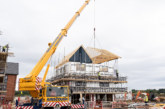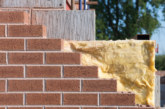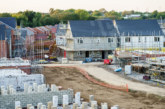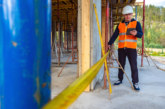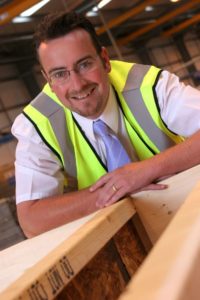 Stewart Dalgarno, AIMCH Project Director and Stewart Milne Group Director of Product Development, discusses the latest innovation in housebuilding.
Stewart Dalgarno, AIMCH Project Director and Stewart Milne Group Director of Product Development, discusses the latest innovation in housebuilding.
In 2019 the annual housebuilding target was missed by 138,978. The UK Government wants 300,000 new homes built a year – a number not hit in 50 years. Traditional methods of construction simply fall short on delivering the volume of homes required.
The events of 2020 have emphasised the need to transform the housing and construction industries if we are to deliver the quality homes needed to meet current and future demand.
Is it possible to build a wind and watertight superstructure in a day?
This is exactly what the Advanced Industrialised Methods for the Construction of Homes project set out to do when started 18 months ago, trialling a range of solutions that could help to tackle the housing crisis by building new homes faster.
Working with the UK’s biggest housebuilders, the project is a national meta-study to compare new and old manufacturing methods on actual building sites, and the impact modern methods of construction has on the housebuilding industry. We are now halfway through the three-year project, and more than ever, we are convinced that MMC, such as offsite panelised systems and digital working, offer unrivalled benefits.
The project is collecting findings across different sub-studies: on-site monitoring, productivity, cost, and digital and industrial innovation. Some of this innovation includes augmented reality, offsite panelised systems, and roof trusses being lifted fully into place.
So the answer to the question is yes, we can build a wind and watertight home structure in a day. In fact homes can be erected in under six hours using Panelised MMC offsite construction technology, and findings from the first half of the project are extremely encouraging showing that we can build homes significantly faster.
Getting to wind and water stage is critical to building a home efficiently and cost effectively. The AIMCH MMC systems ensure the building envelope is completed fast and to a high quality, using pre-insulated wall systems, factory fitted windows, pre-loading materials and roofing systems that can be pre-tiled, without the need for scaffolding or safety decking during the construction process. Optimising the crane to a single day ensures buildings can be progressed internally and externally immediately after the building envelope is completed. From foundation level to completion, can take as little as 8 to10 weeks, depending on house size and complexity, half the time of traditional masonry methods. This balanced approach ensures controlled processes with a high predictability of achieving completion dates on time. Weather risks are eliminated and follow on trades can work in parallel and in harmony, de-risking the reliance on bricklaying skills and availability of workers.
However the fast delivery of homes does not result in reduced quality. In fact, AIMCH study findings so far support a reduction in defects using modern methods of construction. This coupled with the advantages of productivity gain, and the potential for cost reduction, whilst also reducing cash usage and development funding costs, demonstrates that MMC can deliver the transformation required by the industry.
The technological changes mean we’ll also need a workforce equipped with the necessary skillset to support the transformation in housebuilding and construction industries. This brings the opportunity to attract new talent with digital skills, making the sector more appealing and creating a diverse workforce. These new smarter ways of working will help the industry to achieve more with less, the need for which has been highlighted even more this year as the industry adapts to working through ongoing Covid-19 restrictions.
It has been a challenging year for the sector, yet despite this, we are achieving fantastic outcomes. Much has been achieved since the AIMCH project started 18 months ago, and we are incredibly excited about the next part of the journey where we will be looking at creating a future factory model, design standardisation, studying productivity, commercial viability, embodied carbon, and implementing new technologies. We will drive the adoption of MMC by de-risking it for small to medium businesses, making construction a more digitally integrated, manufacturing and assembly-based sector that delivers the required high volume of sustainable quality homes that society needs.

